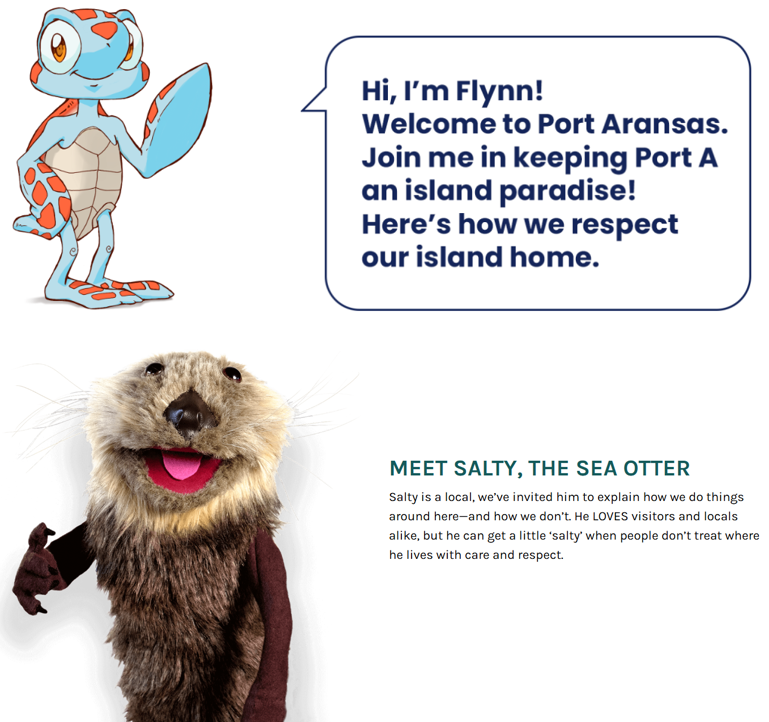
10 Nov Mascots and Characters
WHY IS USING MASCOTS AND CHARACTERS BENEFICIAL
Mascots and characters capture attention and make messages more engaging for travelers at all ages1. They create a memorable and friendly image that resonates with visitors1, helping to convey responsible travel messages in an appealing way. A well-designed mascot can personify the destination’s values and demonstrate environmental care, cultural respect, or sustainable practices2,3. Mascots help create emotional bonds with the audience, which can influence behavior4. Using a recognizable character across different marketing channels as the “face” of the destination provides consistency in messaging. Mascots can embody local culture or wildlife, serving as symbols of what needs to be protected1,5. By utilizing mascots and characters, DMOs can make responsible travel fun.
WHAT IT MEANS
Using mascots and characters means leveraging personified figures or animated personalities to communicate6 and promote responsible travel practices. This is known as anthropomorphism, often applied to robots, which is the attribution of human traits, emotions, or intentions to non-human entities7. Mascots can be used in storytelling, social media campaigns, or educational materials to illustrate what responsible travel looks like in practice. For example, a character might show tourists how to reduce plastic waste or respect wildlife during their visit. Visitors, especially families with children, are more likely to engage with content delivered in a playful way, such as a fun cartoon animal teaching eco-friendly practices. Mascots can be used to serve as visual cues placed throughout tourist sites, reminding visitors of specific behaviors, such as using designated walking paths, conserving water, or supporting local businesses. By creating an emotional or personal connection with travelers, mascots can encourage people to care more deeply about the destination and being a good guest.
HOW TO DO IT
Port Aransas, Texas uses ‘Flynn’ the animated turtle in their “Respect Our Island Home” campaign to welcome guests and share advice on how to be more considerate guests to both the community and the environment. Flynn stars in online and offline campaign messaging such as signs at the beach, window stickers, tote bags, posters and more. Online content includes the destination’s own posts and advertising. Port Aransas uses videos to encourage better behavior.
The Costa Rica Pura Vida Pledge uses an animated sloth to promote environmental responsibility and kindness toward local wildlife. The sloth mascot appears in digital campaigns, signage, and promotional materials to remind tourists to respect nature, avoid disturbing wildlife, and be mindful of their environmental impact. Costa Rica’s focus on sustainability aligns with the friendly, slow-paced nature of the sloth.
In Ucluelet, British Columbia, Canada, Salty the Sea Otter is a local who explains how to treat people where he lives with care and respect, otherwise he can get a little ‘salty.’ He offers responsible travel tips for your visit to Ucluelet such as “Show the locals some love.” -Salty. He teaches visitors how to be a responsible traveler.
DMOs mentioned
https://www.portaransas.org/respect/
https://costarica-sanctuary.com/make-it-happen/
https://www.discoverucluelet.com/responsible-travel/
Other helpful materials
https://innovate.destinationthink.com/explore/responsible-tourism/don%E2%80%99t-forget-to-pack-respect
https://beijingtimes.com/travel/2023/11/26/mascots-in-tourism-from-historic-dragons-to-modern-ai-agents/
Anthropomorphism in hospitality and tourism: A systematic review and agenda for future research (Ding et al., 2022) https://doi.org/10.1016/j.jhtm.2022.07.018
Adding character: The role of destination mascots in tourism development (Radomskaya & Pearce, 2021) https://doi.org/10.1016/j.tourman.2020.104248
References
1. Radomskaya, V., & Pearce, P. L. (2021). Adding character: The role of destination mascots in tourism development. Tourism Management, 84, 104248. https://doi.org/10.1016/j.tourman.2020.104248
2. Joshi, P. (2024). Proceedings for “International Conference on Innovation in Visual Arts (ICIVA’23)”.
3. Lin, Z. (CJ), Ruan, H., Zhang, H., & Xiao, X. (Sivin). (2024). Antecedents, manifestations, and environmental consequences of destination anthropomorphism: The case of nature-based destinations. Journal of Hospitality and Tourism Management, 58, 432–444. https://doi.org/10.1016/j.jhtm.2024.03.001
4. Su, Q., & Li, F. (Sam). (2023). How cute mascots affect relationships with tourism destinations: A moderated mediation model. Tourism Management, 99, 104782. https://doi.org/10.1016/j.tourman.2023.104782
5. Lindström, K. (2019). Classic and cute: Framing biodiversity in Japan through rural landscapes and mascot characters. Popular Communication, 17(3), 233–251. https://doi.org/10.1080/15405702.2019.1567735
6. Jain, R., Luck, E., Mathews, S., & Schuster, L. (2023). Creating Persuasive Environmental Communicators: Spokescharacters as Endorsers in Promoting Sustainable Behaviors. Sustainability, 15(1), Article 1. https://doi.org/10.3390/su15010335
7. Nicolas, S., & Agnieszka, W. (2021). The personality of anthropomorphism: How the need for cognition and the need for closure define attitudes and anthropomorphic attributions toward robots. Computers in Human Behavior, 122, 106841. https://doi.org/10.1016/j.chb.2021.106841

